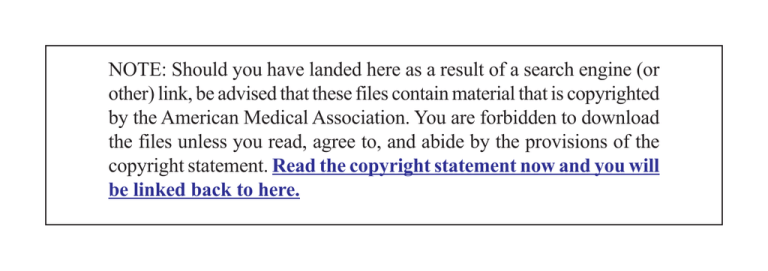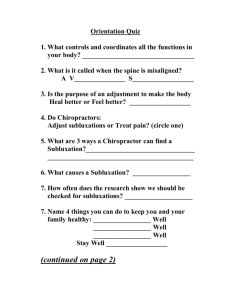
NOTE: Should you have landed here as a result of a search engine (or
other) link, be advised that these files contain material that is copyrighted
by the American Medical Association. You are forbidden to download
the files unless you read, agree to, and abide by the provisions of the
copyright statement. Read the copyright statement now and you will
be linked back to here.
Chiropractic Services - Initial Visit
Documentation Requirements
RAILROAD RETIREMENT BOARD SPECIALTY MEDICARE ADMINISTRATIVE CONTRACTOR (RRB SMAC)
PROVIDER OUTREACH AND EDUCATION
June 2016
What is an Initial Visit ? 2
An initial visit refers to:
The first date of service for a new patient
The first visit for an established patient for a
new/acute subluxation
A visit for an established patient for the first
visit of an exacerbation of a chronic
subluxation
June 2016
Initial Visit Documentation Requirements
Components
3
Initial Visit
IOM 100-02
Chapter 15
Section 240.1.2 Subluxation May
Be Demonstrated
by X-Ray or
Physician’s Exam
Documentation Requirements: Initial Visit
History
Description of Present Illness
Evaluation of Musculoskeletal/Nervous
System through Physical Examination (PART)
Diagnosis
Treatment Plan
Objective Measures to Evaluate Treatment
Effectiveness
Date of Initial Treatment
June 2016
Initial Visit Documentation Requirements
History
4
Initial Visit
IOM 100-02
Chapter 15
Section 240.1.2 Subluxation May
Be Demonstrated
by X-Ray or
Physician’s Exam
1.
History as stated previously to include:
Symptoms causing patient to seek treatment;
Family history if relevant;
Past health history (general health, prior
illness, injuries, or hospitalizations;
medications; surgical history);
June 2016
Initial Visit Documentation Requirements
Present Illness
5
2. Description of the present illness
Initial Visit
including:
IOM 100-02
a)
Chapter 15
Section 240.1.2 Subluxation May
Be Demonstrated
by X-Ray or
Physician’s Exam
b)
c)
d)
e)
f)
Symptoms causing patient to seek treatment
Mechanism of trauma;
Quality and character of
symptoms/problem;
Onset, duration, intensity, frequency,
location, and radiation of symptoms;
Aggravating or relieving factors;
Prior interventions, treatments, medications,
secondary complaints.
June 2016
Initial Visit Documentation Requirements Exam/PART
6
Initial Visit
IOM 100-02
Chapter 15
Section 240.1.2
Subluxation May
Be Demonstrated
by X-Ray or
Physician’s Exam
3. Evaluation of musculoskeletal/nervous system
through physical examination.
Pain/tenderness is evaluated in terms of location,
quality, and intensity;
Asymmetry/misalignment may be identified on a
sectional or segmental level;
Range of motion abnormality results from changes in
active, passive, and accessory joint movements
resulting in an increase or a decrease of sectional or
segmental mobility; and
Tissue, tone and temperature abnormality are
indicated by changes in the characteristics of
associated soft tissues, including skin, fascia, muscle,
and ligament.
June 2016
Initial Visit Documentation Requirements
PART
7
Combine with at least
one of :
Range
of Motion
Abnormality
Pain
Tissue/Tone
Combine with at least
one of :
Asymmetry
Pain
Tissue/Tone
June 2016
Initial Visit Documentation Requirements
Diagnosis
8
Initial Visit
IOM 100-02
Chapter 15
Section 240.1.2
Subluxation May
Be Demonstrated
by X-Ray or
Physician’s Exam
4. Diagnosis: The primary diagnosis must
be subluxation, including the level of
subluxation, either so stated or identified
by a term descriptive of subluxation. Such
terms may refer either to the condition of
the spinal joint involved or to the direction
of position assumed by the particular
bone named.
June 2016
Initial Visit Documentation Requirements
Vertebral Level
9
Initial Visit
IOM 100-02
Chapter 15
Section 240.1.4
Location of
Subluxation
The precise level of the subluxation must
be specified by the chiropractor to
substantiate a claim for manipulation of
the spine. This designation is made in
relation to the part of the spine in which
the subluxation is identified:
June 2016
Initial Visit Documentation Requirements
Vertebral Level
10
Initial Visit
IOM 100-02
Chapter 15
Section 240.1.4
Location of
Subluxation
There are two ways in which the level of
the subluxation may be specified
The
exact bones may be listed, for example: C5, T6, L3, or right ilia
The area may suffice if it implies only
certain bones such as:
Occipito-atlantal (occiput and atlas/C1)
Lumbo-sacral
Sacro-iliac
(L5 and Sacrum)
(sacrum and ilium)
June 2016
Initial Visit Documentation Requirements
Vertebral Level
11
Area of Spine Name of Vertebrae
Number of
Vertebrae
Short Form or
Other Name
Subluxation
ICD - 10 Codes
Neck
Occiput
Cervical
Atlas
Axis
7
Occ, CO
C1 thru C7
C1
C2
M99.00
M99.01
Back
Dorsal or
Thoracic
Costovertebral
Costotransverse
12
D1 thru D12
T1 thru T12
R1 thru R12
R1 thru R12
M99.02
Low Back
Lumbar
5
L1 thru L5
M99.03
Pelvis
Ilia, right and/or left
I, Si
M99.05
Sacral
Sacrum, Coccyx
S, SC
M99.04
June 2016
Initial Visit Documentation Requirements
PART and Subluxation
12
Establishing the Relationship Between the Physical Exam
and Diagnosis
Use guidelines on the P.A.R.T. components to support
subluxation diagnosis List the specific vertebrae that have a subluxation
Document the patient’s symptoms as they relate to the subluxation
June 2016
Initial Visit
Examples of Exam Supported Diagnoses
13
Diagnosis: Dysfunction,
subluxation, or
dislocation thoracic
vertebral region
Thoracic Region Exam
• Pain - VAS 7
• Asymmetry – T4 PR
• Tissue - spasms/inflammation of thoracic
paraspinals
Diagnosis: Dysfunction,
subluxation, or
dislocation lumbar
vertebral region
Lumbar Region Exam
• Pain - VAS 9
• Decreased lumbar ROM
• Tissue – spasms/inflammation of lumbar
paraspinals
Diagnosis: Dysfunction,
subluxation, or
dislocation pelvic
vertebral region
Pelvic Region Exam
• Pain - VAS 7
• Asymmetry – Ilia, right
• Tissue – spasms/ inflammation of right
gluteus minimus
June 2016
Initial Visit Documentation
Treatment Plan of Care
14
Initial Visit
IOM 100-02
Chapter 15
Section 240.1.2
Subluxation May
Be Demonstrated
by X-Ray or
Physician’s Exam
5. Treatment Plan: The treatment plan should
include the following:
Recommended level of care (duration and
frequency of visits);
Specific treatment goals; and
Objective measures to evaluate treatment
effectiveness.
June 2016
Initial Visit Documentation
Treatment Plan of Care
15
Treatment Plan for Mr. John Doe: (Example)
Plan to treat patient 2 times a week for 8 weeks. Than re-evaluate.
Specific treatment goals:
Goal to decrease VAS to 4 or less in 3 weeks.
Goal to be able to walk half an hour without pain.
Objective measures to evaluate treatment effectiveness:
Numerical pain measure is acceptable as an objective measure.
Example: VAS. Terms such as minimal, moderate, or severe are not
acceptable as measures.
Time in walking until pain occurs is another
objective measure.
June 2016
Initial Visit Documentation
Initial Treatment
16
Initial Visit
IOM 100-02
Chapter 15
Section 240.1.2
Subluxation May
Be Demonstrated
by X-Ray or
Physician’s Exam
6. Date of the initial treatment
The Initial Treatment Date
represents the beginning of
the treatment episode
It is the point at which the
medical necessity should
be documented and the
treatment plan initiated
June 2016
Initial Visit Documentation
Manual Manipulation
17
At present the only Medicare
covered service for
chiropractors is Manual
Manipulation of the Spine.
If billing this Initial Visit to
Medicare as a date of
treatment, the Chiropractor
must also document the manual
manipulation given on the day
of the visit.
June 2016
Initial Visit Documentation
Manual Manipulation
18
Document the manual treatment given on the date
of service. Examples are shown below:
C2,T4,
T3
L5 received manual manipulation today.
and L4 manipulated with activator.
Sacroiliac
received treatment by Cox maneuver.
Diversified
treatment to C4, T2, L3 and sacrum.
June 2016
Initial Visit Documentation
Manual Manipulation
19
The only service for chiropractic care with a
Medicare benefit is manual chiropractic
manipulative treatment (CMT):
CPT
98940 - CMT, spinal, one to two regions
CPT
98941 - CMT, spinal, three to four regions
CPT
98942 - CMT, spinal, five regions
The claim must be billed with an AT modifier to
signify the service is active treatment, indicating an
expectation of functional improvement.
CPT codes, descriptors and other data only are copyright 2015 American Medical Association (or such other date of
publication of CPT). All Rights Reserved. Applicable FARS/DFARS apply.
June 2016
Initial Visit
General Documentation Elements
20
All medical records require:
The date of service
The name of the beneficiary
That the documents be
legible
The rendering provider
must sign the notes
June 2016
Chiropractic Services - Resources
21
Chiropractor by Definition: CMS Publication 100-01, Medicare General
Information, Eligibility & Entitlement Manual, Chapter 5, Section 70.6
(http://tinyurl.com/GE100-01CH5)
Chiropractic Coverage: CMS Publication 100-02, Medicare Benefit Policy
Manual, Chapter 15, Section 30.5 (http://tinyurl.com/BP100-02CH15)
Chiropractic Medical Necessity and Documentation Requirements: CMS
Publication 100-02, Medicare Benefit Policy Manual, Chapter 15, Section
240 (http://tinyurl.com/BP100-02CH15)
Chiropractic Documentation Requirements: CMS Publication 100-04,
Medicare Claims Processing Manual, Chapter 12, Section 220
(http://tinyurl.com/CP100-04CH12)
Chiropractic Articles and Resources (http://tinyurl.com/RRMChiro)
Chiropractic Frequently Asked Questions (http://tinyurl.com/RRMChiroFAQs)
June 2016
Chiropractic Services - Resources
22
MLN Matters® Special Edition Articles
SE1601 - Medicare Coverage for Chiropractic Services – Medical Record
Documentation Requirements for Initial and Subsequent Visits
http://tinyurl.com/CMSMLNSE1601
SE1602 - Use of the Active Treatment (AT) Modifier for Chiropractic Billing
http://tinyurl.com/CMSMLNSE1602
SE1603 - Educational Resources to Assist Chiropractors with Medicare Billing
http://tinyurl.com/CMSMLNSE1603
SE1101 - Overview of Medicare Policy Regarding Chiropractic Services
http://tinyurl.com/CMSMLNSE1101
June 2016
Chiropractic Services – Initial Visit
23
Palmetto GBA Railroad Medicare appreciates your interest in the subject presented.
June 2016


